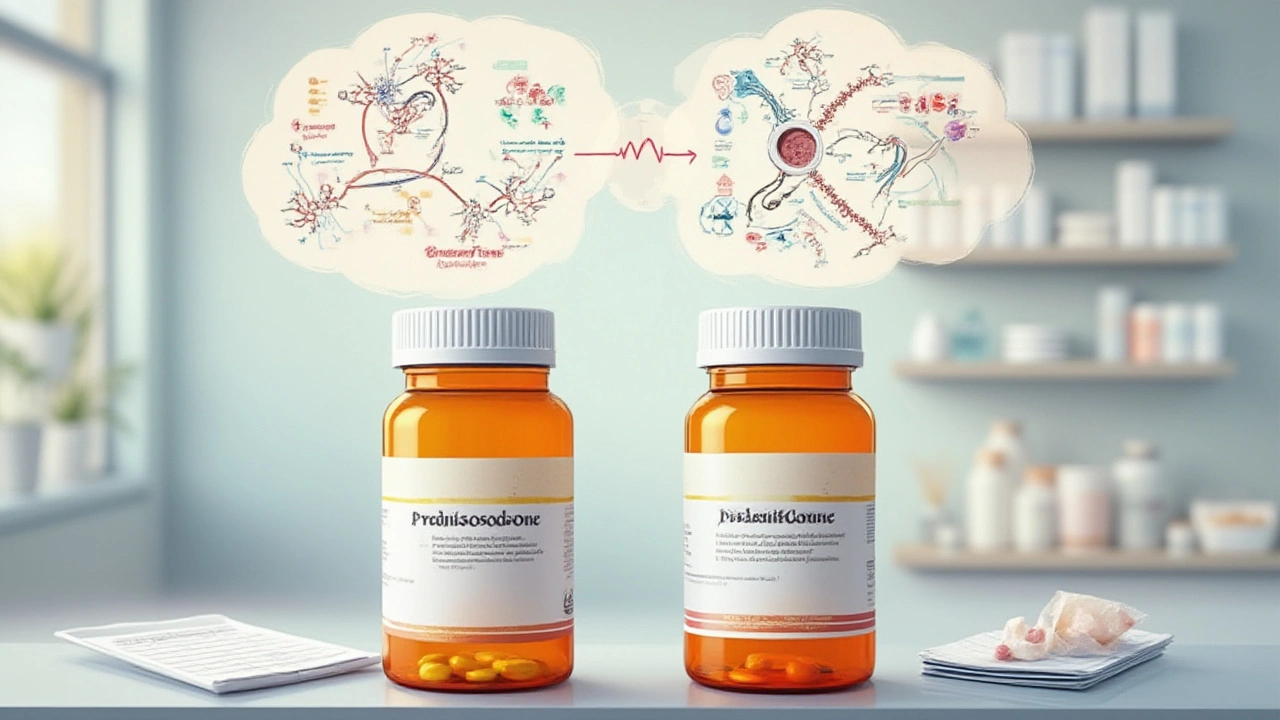We expect medications with similar names to work the same, don’t we? But when you hold a bottle of prednisolone in one hand and prednisone in the other, you’re actually looking at two steroids with very different stories. Sure, they both ease inflammation and calm autoimmune flare-ups, but the way your body handles each can change your day-to-day experience—right down to the last side effect.
How Your Body Processes Prednisolone and Prednisone
First, let’s bust a myth. Prednisolone and prednisone are not chemically identical twins. Prednisone works like a ‘prodrug.’ That means your liver has to switch it on by converting it into prednisolone, the active form. If your liver isn’t working at its best—due to age, disease, or something else—prednisone might not give you the full benefit. On the flip side, prednisolone is ready to act right away. This subtle difference actually shapes the risk for side effects and how you’ll feel on your medication.
Most people process prednisone and prednisolone without much trouble. But numbers say otherwise for people with liver conditions—about 10% of adults with compromised liver function can’t activate prednisone efficiently. For them, doctors usually skip straight to prednisolone for reliable anti-inflammatory action. Now, isn’t it odd to think your genetic makeup or liver health could decide which steroid makes you feel better—or worse?
Metabolism speed matters big time. Prednisone can linger longer in people who metabolize drugs slowly. That means a higher level of steroids hanging around in the blood, raising the odds of mood swings, insomnia, or puffy cheeks. Prednisolone, already active, moves through a bit faster. Some studies show prednisolone clears from your bloodstream in about 2.5 to 3 hours, compared to roughly 3.5 hours for prednisone. This might seem minor, but sensitive folks actually report fewer ‘hangover’ feelings the next day when they use prednisolone.
Dosing Differences: Why It’s Not Always a Simple Swap
You might hear someone say, “Isn’t 10 mg of prednisone the same as 10 mg of prednisolone?” Sounds logical, right? Here’s the thing—it’s mostly true. They have nearly identical anti-inflammatory power, so most dosing guides treat them as equivalent milligram-for-milligram. But doctors keep a watchful eye when swapping from one to the other, especially if a patient’s liver function is on the line or the person is very young or older.
Kids, for example, are more likely to be prescribed liquid prednisolone (because, really, chewable prednisone isn’t a thing). In elderly patients, small dosing hiccups can snowball into bigger side effects, so the fast-acting predictability of prednisolone is a favorite when liver health is in doubt. The packaged dosing is nearly always matched, but starting a new steroid sometimes means a dose tweak based on your weight, other meds, or how your immune system is behaving lately. People often underestimate how those small adjustments can make a world of difference in insomnia, appetite, or irritability.
If you ever wondered why your doctor asks you to report back soon after a steroid change, now you know. The right dose on paper doesn’t always feel right in real life. Being switched from prednisone to prednisolone, or vice versa, can lead to minor hiccups in how you sleep or how fast you gain water weight. Even the time of day you take your dose (morning is usually best) can play into the risk and intensity of side effects, especially for people sensitive to energy crashes or food cravings late in the day.

Comparing Side Effects: What Really Changes?
Ask people about side effects from steroids and you’ll hear it all—insomnia, mood swings, round face, stomach trouble, maybe even eye changes or skin thinning. Both prednisolone and prednisone can trigger all these. But subtle pharmacokinetic differences do change the risk landscape a bit.
When the body switches prednisone into prednisolone, a tiny fraction of the prednisone might hang around longer if you have slower metabolism. This linger time may not sound like a big deal, but it can be the tipping point if you’re fighting insomnia, anxiety, or energy slumps. For folks whose livers work fine, both drugs clear at similar rates—but if liver function drops, prednisone’s side effects are more likely to stack up.
Another twist: if you’re taking other meds that stress your liver, prednisone may be the trickier choice. Blood pressure pills, antifungals, anti-seizure meds, even certain antibiotics, can all fiddle with liver enzymes that process prednisone. So what starts as a “routine” dose might leave you with surprise swelling, mood shifts, or blood pressure hiccups. With prednisolone, since it’s already active, your liver has one less chore. This is why doctors may lean toward prednisolone for patients balancing a smorgasbord of prescriptions.
Want to dive even deeper? Check out details on the side effect of prednisolone at Enkehaus Pharmacy for a deep-dive into real-world side effect stories and guidance.
Something else worth knowing: prednisolone passes a bit more easily into brain and eye tissues, meaning you’ll see it prescribed for eye inflammation or after some types of surgery. This tissue access can be a double-edged sword, delivering better results but raising the risk of, say, pressure changes in the eyes for folks with glaucoma.
Patient Experiences: Why Some People Notice a Difference
So what’s it like day-to-day? Some people can’t tell which steroid they’re taking. But a surprising number report real differences when switching between prednisolone and prednisone, and it’s not all in their heads. I’ve heard stories from parents who said their kids had fewer mood swings and better sleep on prednisolone syrup compared to prior rounds on prednisone tablets. Elderly folks sometimes remark that prednisolone causes less muscle weakness when taken for months on end.
The why comes down to those small metabolic details. For anyone with wobbly liver function, the efficiency of prednisolone means less build-up, so you’re less likely to feel groggy after a dose. Asthma patients on long-term steroids, for example, often find prednisolone less likely to trigger wild appetite spikes and fluid retention if their livers work slowly. If someone is on steroids plus a raft of other meds—think transplant recipients, people on HIV drugs, or polypharmacy seniors—the easier metabolism of prednisolone can mean fewer clashes and less risk for oddball side effects.
A little tip for people experiencing side effects: take your daily dose early in the morning with food. That cuts the risk for stomach upset and sleeplessness, regardless of which steroid you’re on. If you’re switching between drugs and notice any sudden swelling, vision changes, or mood crashes, call your doctor right away—sometimes all it takes is a dose or timing tweak. And hydration matters more than you think; steroids can raise your salt levels and increase thirst, leading to headaches or bloating if you’re not mindful.

How to Talk to Your Doctor About Choosing the Right Steroid
It’s tempting to assume your doctor will handle everything, but having the right questions makes all the difference. Start with: “Why are you choosing this steroid for me?” If you have liver issues or you’re on other meds that mess with metabolism, ask if prednisolone is the safer pick. If your pharmacy wants to swap one for the other due to a shortage or insurance hiccup, ask to double-check the dose and discuss possible side effects—even small changes in how your body processes drugs can turn up after a switch.
Don’t hesitate to talk about your experience of side effects—mention if you’ve had mood swings, sleep issues, or stomach upset on previous steroids. Doctors aren’t mind-readers and might adjust your plan if they know how you really feel. Always check before stopping steroids abruptly, since both drugs can suppress your natural cortisol if used for a week or more. If you’re nervous about long-term effects, bring it up early. Doses can often be tapered or alternated with non-steroid treatments to reduce risks over time.
For anyone who’s moved between prednisone and prednisolone, keeping a diary of your symptoms for a few days can give your doctor great clues on how your body reacts. Note anything unusual: headaches, appetite changes, mood swings, or blurry vision. If you’ve experienced a side effect in the past, mention it right away. Some side effects may show up only after days or weeks, and they’re easier to handle when flagged early.
